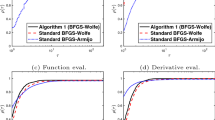Abstract
This paper presents a new method that effectively determines a Pareto front for bi-objective optimization with potential application to multiple objectives. A traditional method for multiobjective optimization is the weighted-sum method, which seeks Pareto optimal solutions one by one by systematically changing the weights among the objective functions. Previous research has shown that this method often produces poorly distributed solutions along a Pareto front, and that it does not find Pareto optimal solutions in non-convex regions. The proposed adaptive weighted sum method focuses on unexplored regions by changing the weights adaptively rather than by using a priori weight selections and by specifying additional inequality constraints. It is demonstrated that the adaptive weighted sum method produces well-distributed solutions, finds Pareto optimal solutions in non-convex regions, and neglects non-Pareto optimal solutions. This last point can be a potential liability of Normal Boundary Intersection, an otherwise successful multiobjective method, which is mainly caused by its reliance on equality constraints. The promise of this robust algorithm is demonstrated with two numerical examples and a simple structural optimization problem.
Similar content being viewed by others
References
Das, I.; Dennis, J.E. 1997: A closer look at drawbacks of minimizing weighted sums of objectives for Pareto set generation in multicriteria optimization problems. Struct Optim14, 63–69
Das, I.; Dennis, J.E. 1998: Normal-Boundary Intersection: A New Method for Generating Pareto Optimal Points in Multicriteria Optimization Problems. SIAM J Optim8, 631–657
Fonseca, C.; Fleming, P. 1995: An overview of evolutionary algorithms in multiobjective optimization. Evol Comput3, 1–18
Goldberg, D.E. 1989: Genetic Algorithms in Search, Optimization and Machine Learning. Boston, MA: Addison Wesley
Koski, J. 1985: Defectiveness of weighting method in multicriterion optimization of structures. Commun Appl Numer Methods1, 333–337
Koski, J. 1988: Multicriteria truss optimization. In: Stadler, W. (ed.) Multicriteria Optimization in Engineering and in the Sciences, New York: Plenum
Lin, J. 1976: Multiple objective problems: Pareto-optimal solutions by method of proper equality constraints. IEEE Trans Autom Control21, 641–650
Marglin, S. 1967: Public Investment Criteria. Cambridge, MA: MIT Press
Messac, A.; Mattson, C.A. 2002: Generating Well-Distributed Sets of Pareto Points for Engineering Design using Physical Programming. Optim Eng3, 431–450
Messac, A.; Ismail-Yahaya, A.; Mattson, C.A. 2003: The Normalized Normal Constraint Method for Generating the Pareto Frontier. Struct Multidisc Optim25, 86–98
Mattson, C.A.; Messac, A. 2003: Concept Selection Using s-Pareto Frontiers. AIAA J41, 1190–1204
Messac, A.; Mattson, C.A. 2004: Normal Constraint Method with Guarantee of Even Representation of Complete Pareto Frontier. AIAA J42
Pareto, V. 1906: Manuale di Economia Politica, Societa Editrice Libraria, Milano, Italy. Translated into English by Schwier, A.S. 1971: Manual of Political Economy, New York: Macmillan
Stadler, W. 1979: A Survey of Multicriteria Optimization, or the Vector Maximum Problem. JOTA29, 1–52
Stadler, W. 1984: Applications of Multicriteria Optimization in Engineering and the Sciences (A Survey). In: Zeleny, M. (ed.) Multiple Criteria Decision Making – Past Decade and Future Trends. Greenwich, CT: JAI
Steuer, R.E. 1986: Multiple Criteria Optimization: Theory, Computation and Application. New York: Wiley
Suppapitnarm, A.; Seffen, K.A.; Parks, G.T.; Clarkson, P.J. 2000: A simulated annealing algorithm for multiobjective optimization. Eng Optim33(1), 59–85
Schy, A.A.; Giesy, D.P. 1988: Multicriteria Optimization for Design of Aircraft Control Systems. In: Stadler, W. (ed.) Multicriteria Optimization in Engineering and in the Sciences, New York: Plenum, p.225–262
Tamaki, H.; Kita, H.; Kobayashi, S. 1996: Multiobjective optimization by genetic algorithms: a review. 1996 IEEE International Conference on Evolutionary Computation, ICEC 1996, Nagoya, Japan
Zadeh, L. 1963: Optimality and Non-Scalar-Valued Performance Criteria. IEEE Trans Autom Control8, 59–60
Author information
Authors and Affiliations
Corresponding author
Rights and permissions
About this article
Cite this article
Kim, I., de Weck, O. Adaptive weighted-sum method for bi-objective optimization: Pareto front generation. Struct Multidisc Optim 29, 149–158 (2005). https://doi.org/10.1007/s00158-004-0465-1
Received:
Revised:
Published:
Issue Date:
DOI: https://doi.org/10.1007/s00158-004-0465-1




